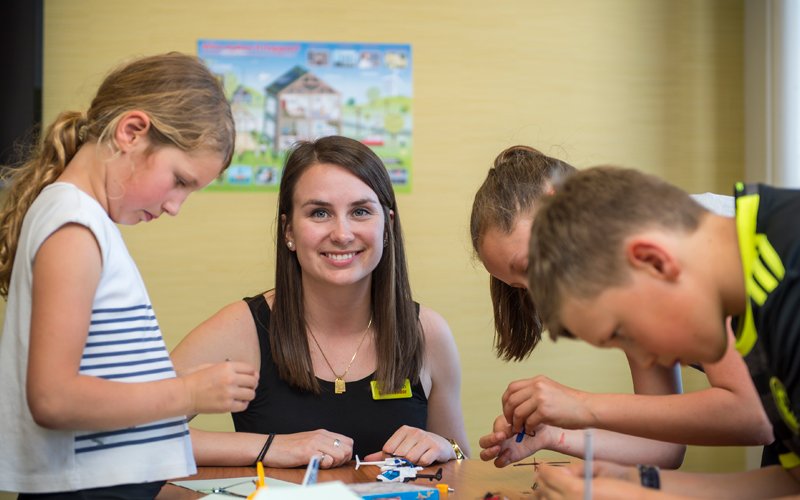Workplace culture and women’s experiences were widely discussed, and diversity increasingly featured in conversation as good for business. IPENZ published a number of articles on these topics in its magazine. It also continued to focus on its schools programme as a way of increasing the number of women in the profession.
Universities
Through the 1990s there was a sustained rise in the percentage of female engineering students at the two main engineering schools – Auckland and Canterbury, from around 12 percent in 1990 to hover between 16 percent and 20 percent by 2000. The percentage of women then plateaued during the period 2000–2010, on average, floating just above 20 percent. Through the 2000s, both Auckland and Canterbury universities continued to run their successful faculty open day programmes and to strengthen their women in engineering groups.

From left, students Esther and Alice Hausia and Jasmin Wagner of Onehunga High School attend Enginuity Day at University of Auckland, 2007. Activities that year included programming a robot and developing cellphone software. Photo: © Stuff Limited
IPENZ
Through the 2000s IPENZ showed concern at the continued low numbers of women in the engineering profession. While graduate numbers were sitting around 20 percent, this did not translate into an increasing number of women working as professional engineers. In the 2000s, women made up between 4 percent and 6 percent of engineers, with numbers varyingly greatly across the different engineering disciplines. Of most concern were statistics that showed women were leaving the profession at higher rates than their male counterparts. After only five years in the profession the proportion of women showed a noticeable decline, and after 10 years, was down to 3 percent. Women in senior and upper management roles were almost non-existent. IPENZ used its publication, e.nz magazine, to draw attention to and discuss the issue. Diversity in the profession was positioned as smart business sense – improving staff retention and productivity and equipping an organisation to better respond to the diversity of their customers and community.
There was also greater recognition that while many companies had equity policies, in practice the situation was more complex. At an IPENZ Women in Engineering workshop held in 2006, “attendees agreed that while the engineering profession offers equal opportunity ‘on the face of things’, female engineers still encounter subtle barriers.” Suggested reasons women chose to leave the profession included workplace culture, long work hours, and an emphasis on technical skills at the expense of social and collaborative skills. Other issues identified included “boys club” networking opportunities that women may not feel comfortable participating in; a reluctance on the part of women to push for promotion until they felt at least 90 percent competent in their current role; and unconscious bias resulting in women being given fewer opportunities and less challenging projects. The idea that women will “go off and have children” also continued to loom quietly in the background. The 2006 workshop also gathered ideas on ways to retain women. Ideas included educating managers on unconscious bias, actively mentoring female engineers, profiling successful women engineers as role models and offering more flexible working hours and meaningful part-time work.
Begun in 2003, Futureintech was the new iteration of IPENZ’s schools programme. It aimed to increase the number of students considering a career in STEM. There was concern that graduate numbers had stagnated and there would not be enough engineering and technology professionals to fill New Zealand’s future need. The programme was also concerned with the underrepresentation of women, Māori and Pasifika in STEM fields. In its first years the initiative was funded by New Zealand Trade and Enterprise, and later by Callaghan Innovation through the Ministry of Business, Innovation and Employment (MBIE).

Airworthiness engineer and Futureintech Ambassador Andrea Wadsworth, 2017. Photo: Engineering New Zealand
The programme employed Regional Facilitators who connected with primary and secondary schools to provide support and information for teachers. IPENZ members volunteered as Futureintech Ambassadors, giving presentations at careers evenings and going into schools to talk to classes about their careers and to support students’ curriculum-based work on technology projects. Futureintech also produced a newsletter for industry and a website with information for teachers, careers advisors and students about STEM careers. In 2017, the programme had 947 registered ambassadors, 46 percent of whom were female, and reached 48,818 students in 347 schools.
Conclusion
By 2010, the issues women still sometimes came up against in the workplace were much better understood and proactively addressed by companies. Women’s enrolment in engineering courses at Auckland and Canterbury were stable at just above 20 percent and universities and IPENZ maintained and strengthened their outreach programmes to schools.

Diversity in 2010–2024
In the 2010s and 2020s bold new initiatives focused on diversity and inclusion have made engineering a more welcoming place for all.


